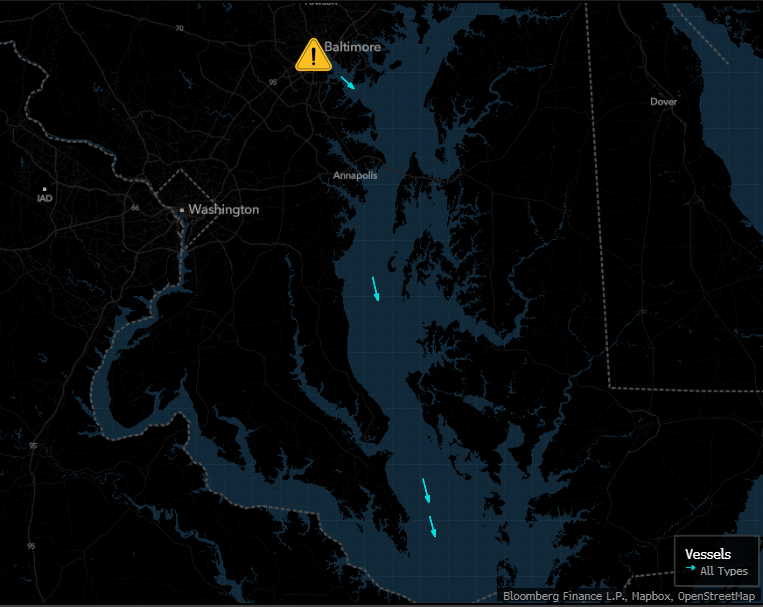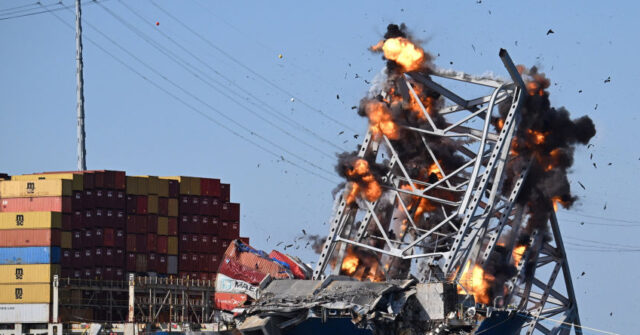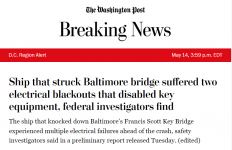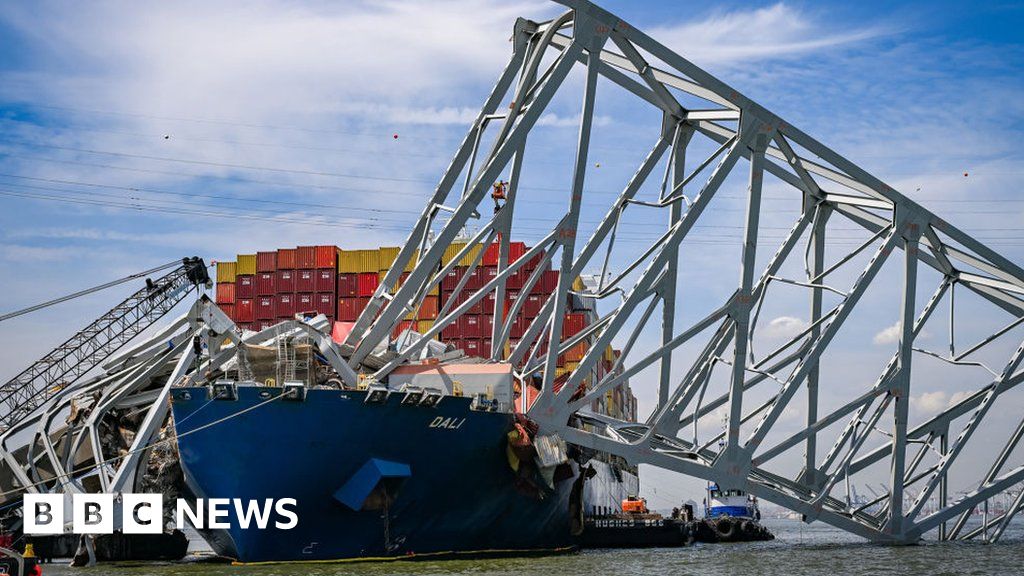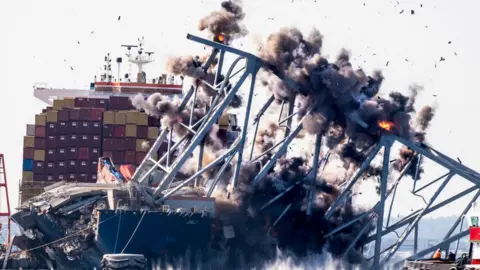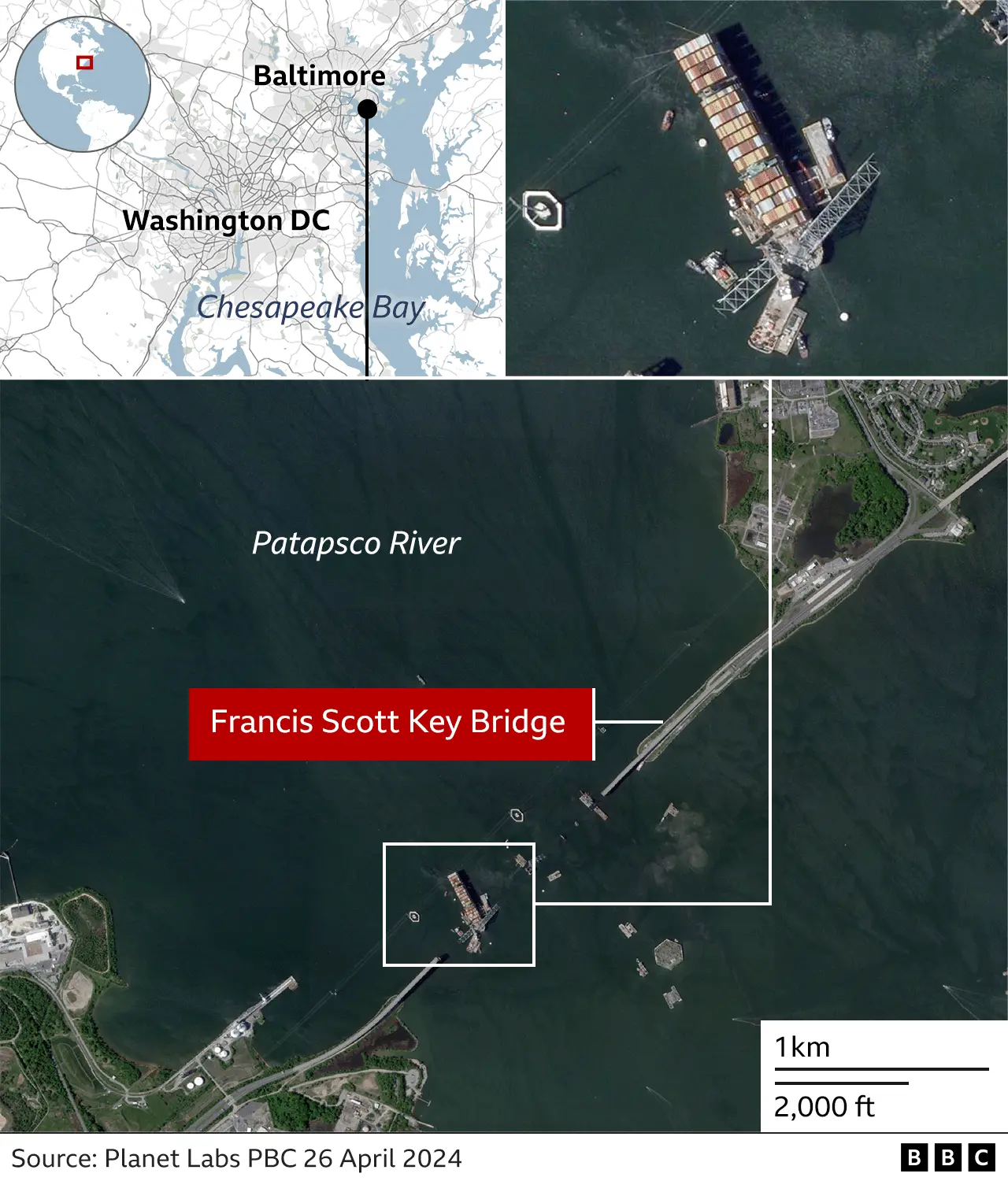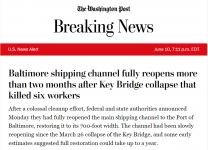The Department of Justice on Wednesday filed a lawsuit against Grace Ocean Private Limited and Synergy Marine Private Limited, the owners and operators of the Dali, the Singaporean ship that collided with and destroyed Baltimore’s Francis Scott Key Bridge in March.

www.thegatewaypundit.com
DOJ Files $100M Lawsuit Against Owner and Operator of Ship That Destroyed Baltimore's Francis Scott Key Bridge
Francis Scott Key Bridge collapses following container ship collision – March 26, 2024
The Department of Justice on Wednesday filed a lawsuit against Grace Ocean Private Limited and Synergy Marine Private Limited, the owners and operators of the Dali, the Singaporean ship that collided with and destroyed Baltimore’s Francis Scott Key Bridge in March.
The Gateway Pundit reported on the bridge’s collapse after the Dali took out a support column.
The Key Bridge is a major commuter route that carries the Baltimore Beltway I-695 over the Patapsco River at the southern end of Baltimore Harbor.
The Gateway Pundit reported that Grace Ocean Private Limited previously “denied any fault or neglect of the collapse of the Francis Scott Key Bridge” and requested to be exonerated from all liability for the Key Bridge’s collapse in a federal court filing.
“With this civil claim, the Justice Department is working to ensure that the costs of clearing the channel and reopening the Port of Baltimore are borne by the companies that caused the crash, not by the American taxpayer,” Attorney General Merrick Garland said in a press release.
The suit alleges that the incident was "entirely avoidable," arguing that electrical and mechanical systems were improperly maintained and violated safety regulations, and the ship was in "unseaworthy condition." Additionally, the complaint argues that "none of the four means available to help control the DALI—her propeller, rudder, anchor, or bow thruster—worked when they were needed to avert or even mitigate this disaster." The issues that led to the ship losing power multiple times and colliding with the bridge are credited by the Justice Department to the operators' decisions, which were "made to save money and for their own convenience."
Prior to the collision, the ship underwent multiple power losses while at the pier, including on March 25, before the incident occurred shortly after midnight on March 26. Despite an obligation to report the power loss, "the DALI’s power losses in Baltimore were not reported to the Coast Guard," the complaint states. Additionally, the ship failed to inform the pilot steering the ship of the irregularities and ship's defects, the lawsuit claims.
The complaint states, "As a result of the disaster, the United States incurred more than $100,000,000 in losses and response costs in the course of clearing the wreck and bridge debris from the navigable channel to reopen the Port of Baltimore." In addition to approximately $103,078,056 in damages, the United States also seeks punitive damages in an amount to be determined by the Court, citing the companies' gross negligence, willful, wanton, and reckless indifference.
"The new claims provide the most detailed account yet of what led to the bridge’s total collapse early March 26," Baltimore Banner reports.
More from Baltimore Banner:
The Dali included a rigged transformer that had been repeatedly cracking from excessive vibrations and a “recklessly disabled” backup circuit system, the government alleges. Recent inspections had found loose bolts, nuts and washers and broken electrical cable ties inside the transformers and switchboards.
The ship’s electrical equipment was so poor that one agency stopped electrical testing because of “safety concerns,” according to the government’s court filing.
With a deadline looming next week to respond to the Dali operators’ petition to limit their liability, new legal claims are flowing in.
A criminal investigation is ongoing, officials said, as well as a National Transportation Safety Board inquiry. Certain members of the Dali crew, who hailed almost entirely from India, remain in Baltimore voluntarily to assist in the investigation, officials said.
You can read the full complaint here.
Press release from DOJ:
Claim Seeks Over $100M in Costs Incurred to Reopen Access to the Port of Baltimore and Punitive Damages for the Owner and Operator’s Reckless Conduct
The Justice Department filed a civil claim today in the U.S. District Court for the District of Maryland against Grace Ocean Private Limited and Synergy Marine Private Limited, the Singaporean corporations that owned and operated the container ship that destroyed the Francis Scott Key Bridge.
In the early morning hours of March 26, the Motor Vessel DALI left the Port of Baltimore bound for Sri Lanka. While navigating through the Fort McHenry Channel, the vessel lost power, regained power, and then lost power again before striking the bridge. The bridge collapsed and plunged into the water below, tragically killing six people. In addition to this heartbreaking loss of life, the wreck of the DALI and the remnants of the bridge obstructed the navigable channel and brought all shipping into and out of the Port of Baltimore to a standstill. The loss of the bridge also severed a critical highway in our transportation infrastructure and a key artery for local commuters.
The suit seeks to recover over $100 million in costs the United States incurred in responding to the fatal disaster and for clearing the entangled wreck and bridge debris from the navigable channel so the port could reopen.
“The Justice Department is committed to ensuring accountability for those responsible for the destruction of the Francis Scott Key Bridge, which resulted in the tragic deaths of six people and disrupted our country’s transportation and defense infrastructure,” said Attorney General Merrick B. Garland. “With this civil claim, the Justice Department is working to ensure that the costs of clearing the channel and reopening the Port of Baltimore are borne by the companies that caused the crash, not by the American taxpayer.”
The United States led the response efforts of dozens of federal, state, and local agencies to remove about 50,000 tons of steel, concrete, and asphalt from the channel and from the DALI itself. While these removal operations were underway, the claim alleges that the United States also cleared a series of temporary channels to start relieving the bottleneck at the port and mitigate some of the economic devastation caused by the DALI. The Fort McHenry Channel was cleared by June 10, and the Port of Baltimore was once again open for commercial navigation.
“The owner and operator of the DALI were well aware of vibration issues on the vessel that could cause a power outage. But instead of taking necessary precautions, they did the opposite,” said Principal Deputy Associate Attorney General Benjamin C. Mizer. “Out of negligence, mismanagement, and, at times, a desire to cut costs, they configured the ship’s electrical and mechanical systems in a way that prevented those systems from being able to quickly restore propulsion and steering after a power outage. As a result, when the DALI lost power, a cascading set of failures led to disaster.”
Indeed, the lawsuit specifically asserts that none of the four means that should have been available to help steer the DALI — the propeller, rudder, anchor, or bow thruster — worked when they were needed to avert or even mitigate this disaster.
“This was an entirely avoidable catastrophe, resulting from a series of eminently foreseeable errors made by the owner and operator of the DALI,” said Principal Deputy Assistant Attorney General Brian M. Boynton, head of the Justice Department’s Civil Division. "The suit seeks to recover the costs incurred by the United States in responding to this disaster, which include removing the bridge parts from the channel and those parts that were entangled with the vessel, as well as abating the substantial risk of oil pollution.”
“In so many ways, the Key Bridge has symbolized the resilience of both the State of Maryland and our Nation. In a very real way, the Key Bridge was a pathway to the American Dream. A part of our culture is gone,” said U.S. Attorney Erek L. Barron for the District of Maryland. “Those responsible for the Key Bridge collapse will be held accountable.”
The Justice Department’s claim also seeks punitive damages to deter the owner and operator of the DALI and others. During a press call announcing the Justice Department’s actions, Acting Deputy Assistant Attorney General Chetan Patil of the Civil Division explained, “This accident happened because of the careless and grossly negligent decisions made by Grace Ocean and Synergy, who recklessly chose to send an unseaworthy vessel to navigate a critical waterway and ignored the risks to American lives and the nation’s infrastructure.”
The Department’s claim is part of a legal action the owner and operator of the DALI initiated shortly after the tragedy, in which they seek exoneration or limitation of their liability to approximately $44 million.
“Wholly preventable failures by the owner and operator of the DALI caused this tragic incident that cost six bridge construction workers their lives and closed one of the largest ports on the East Coast,” said Rear Admiral Laura M. Dickey, Deputy for Operations Capability and Policy of the U.S. Coast Guard. “The Coast Guard quickly responded by establishing a Unified Command with federal, state, and local stakeholders to rapidly open alternative channels and restore the Port of Baltimore to full operations in just over two months. We stand ready to support the Justice Department to ensure that those responsible for this tragedy pay the costs of reopening the Port.”
The claim on behalf of the United States does not include any damages for the reconstruction of the Francis Scott Key Bridge. The State of Maryland built, owned, maintained, and operated the bridge, and attorneys on the State’s behalf may file their own claim for those damages. Subsequently, pursuant to the governing regulation, funds recovered by the State of Maryland for reconstruction of the bridge will be used to reduce the project costs paid by federal taxpayer dollars.
The United States is represented in the filed action by attorneys from the Civil Division’s Aviation, Space & Admiralty Litigation Section and from the U.S. Attorney’s Office for the District of Maryland, Baltimore Division.
The claims alleged by the United States are allegations only. There has been no determination of liability.

